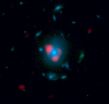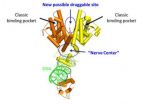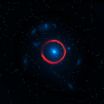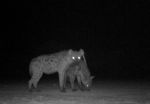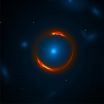(Press-News.org) Some of the brightest galaxies in the universe – infant galaxies that churned out tens of thousands of stars each year at the dawn of the universe – evolved much sooner and in greater numbers than previously thought, according to new measurements obtained by University of Arizona astronomers.
The results are published in a set of papers to appear in the journal Nature on March 14 and in the Astrophysical Journal. The research is the most recent example of the discoveries coming from the new international ALMA observatory, which celebrates its inauguration today. ALMA, which stands for Atacama Large Millimeter/submillimeter Array, is an array of 66 radio telescopes located in the dry and cloudless Atacama Desert in Chile.
The most intense bursts of star birth are thought to have occurred in the early universe, in massive, bright galaxies. These starburst galaxies used to convert vast reservoirs of cosmic gas and dust into new stars at a furious pace – many hundreds of times faster than in stately spiral galaxies like our own Milky Way. By looking far into space, at galaxies so distant that their light has taken many billions of years to reach us, astronomers can observe this busy period in the universe's youth.
"Even though these galaxies are among the brightest objects in the universe, they are very hard to see with telescopes that detect visible light, such as the Hubble Space Telescope," said Dan Marrone, an assistant professor at the UA's Steward Observatory and a leading author on the publications. The reason, Marrone explained, is that these young galaxies are enshrouded in thick clouds of dust. "Instead, we use ALMA to look for them in light coming from the dust itself. To ALMA, these are some of the brightest objects in the sky outside our own galaxy."
The international team of researchers first discovered these distant and enigmatic starburst galaxies with the National Science Foundation's 10-meter South Pole Telescope and then used ALMA to zoom in on them to explore the stellar baby boom in the young universe. They were surprised to find that many of these distant dusty star-forming galaxies are even farther away than expected. This means that, on average, their bursts of star birth took place 12 billion years ago, when the universe was just under 2 billion years old – a full billion years earlier than previously thought.
Two of these galaxies are the most distant of their kind ever seen – so distant that their light began its journey when the universe was only 1 billion years old. One of them appears to host the most intense burst of star formation that has ever been seen. Water molecules are also detected in that same galaxy, marking the most distant observations of water in the cosmos published to date.
The team used the unrivalled sensitivity of ALMA to capture light from 26 of these galaxies at wavelengths of around three millimeters. Molecules of carbon monoxide, a poisonous gas that is also the second most abundant molecule in the universe, are created in the star-forming gas in these galaxies and emit light at certain specific wavelengths. These wavelengths are stretched by the expansion of the universe over the billions of years that it takes the light to reach us. By measuring the stretched wavelengths, astronomers can calculate how long the light's journey has taken, and place each galaxy at the right point in cosmic history.
"The sensitivity of ALMA allowed us to do in a few minutes per galaxy what used to require hours or even multiple nights," said Joaquin Vieira, postdoctoral scholar at the California Institute of Technology and lead author on the Nature paper.
The astronomers were using only a partial array of 16 of ALMA's 66 giant antennas, as the observatory was still under construction at an altitude of 5,000 meters on the remote Chajnantor Plateau in the Chilean Andes. When complete, ALMA will be even more sensitive, and will be able to detect even fainter galaxies.
For now, the team targeted the brighter ones. It took advantage of a helping hand from nature, too: using gravitational lensing, an effect predicted by Einstein's general theory of relativity, where light from a distant galaxy is distorted by the gravitational influence of a nearer foreground galaxy, which acts like a lens and makes the distant source appear brighter.
"Gravitational lensing causes the light from the distant galaxies to trace out a large, magnified circle around the lensing galaxy," explained UA astronomy graduate student and coauthor Justin Spilker, who has been analyzing the ALMA data and helped create the images revealing the galaxies' structure.
"This makes them much easier to see, and we use our understanding of gravity to take out the effect of the lensing and recreate the structure of the distant galaxy. The mass of these distant galaxies provides us with natural telescopes to view objects even further away."
Analysis of the distortion reveals that some of the distant star-forming galaxies are as bright as 40 trillion (40 million million) suns, and that gravitational lensing has magnified this by up to 22 times.
Marrone, who is the principal investigator of the gravitational lensing portion of the project, explained that because only those super-distant galaxies can be discovered that happen to lie in perfect alignment with another galaxy that can act as a lens and the Earth, it is likely that they are much more abundant than previously thought.
"It has been thrilling to be among the first to use ALMA to study the very early universe," added Spilker. "We are now trying to use the molecules we see to explain how and why these galaxies were so active, so soon after the Big Bang."
INFORMATION:
The research is described in the paper "Dusty starburst galaxies in the early Universe as revealed by gravitational lensing", by J. Vieira et al., in the journal Nature. The work to measure the distances to the galaxies is described in the paper "ALMA redshifts of millimeter-selected galaxies from the SPT survey: The redshift distribution of dusty starforming galaxies", by A. Weiss et al., in the Astrophysical Journal. The study of the gravitational lensing is described in the paper "ALMA observations of strongly lensed dusty starforming galaxies", by Y. Hezaveh et al., also in the Astrophysical Journal.
About ALMA:
The Atacama Large Millimeter/submillimeter Array (ALMA), an international astronomy facility, is a partnership of Europe, North America and East Asia in cooperation with the Republic of Chile. ALMA is funded in Europe by the European Southern Observatory (ESO), in North America by the U.S. National Science Foundation (NSF) in cooperation with the National
Research Council of Canada (NRC) and the National Science Council of Taiwan (NSC) and in East Asia by the National Institutes of Natural Sciences (NINS) of Japan in cooperation with the Academia Sinica (AS) in Taiwan. ALMA construction and operations are led on behalf of Europe by ESO, on behalf of North America by the National Radio Astronomy Observatory (NRAO), which is managed by Associated Universities, Inc. (AUI) and on behalf of East Asia by the National Astronomical Observatory of Japan (NAOJ). The Joint ALMA
Observatory (JAO) provides the unified leadership and management of the construction, commissioning and operation of ALMA.
ALMA exposes hidden star factories in the early universe
Using entire galaxies as gigantic gravitational lenses, UA astronomers have obtained new measurements of some of the oldest galaxies in the universe
2013-03-14
ELSE PRESS RELEASES FROM THIS DATE:
Molecule's structure reveals new therapeutic opportunities for rare diabetes
2013-03-14
ORLANDO, Fla., March 13, 2013 – Researchers at Sanford-Burnham Medical Research Institute (Sanford-Burnham) have determined the complete three-dimensional structure of a protein called HNF-4α. HNF-4α controls gene expression in the liver and pancreas, switching genes on or off as needed. People with mature onset diabetes of the young (MODY1), a rare form of the disease, have inherited mutations in the HNF-4α protein. This first-ever look at HNF-4α's full structure, published March 13 in Nature, uncovers new information about how it functions. The study ...
New monoclonal antibody developed that can target proteins inside cancer cells
2013-03-14
NEW YORK, MARCH 13, 2013 – Researchers have discovered a unique monoclonal antibody that can effectively reach inside a cancer cell, a key goal for these important anticancer agents, since most proteins that cause cancer or are associated with cancer are buried inside cancer cells. Scientists from Memorial Sloan-Kettering Cancer Center and Eureka Therapeutics have collaborated to create the new human monoclonal antibody, which targets a protein associated with many types of cancer and is of great interest to cancer researchers.
Unlike other human therapeutic monoclonal ...
'Nuisance' data lead to surprising star-birth discovery
2013-03-14
When a batch of bright cosmic objects first appeared in maps in 2008 made with data from the South Pole Telescope, astronomers at the University of Chicago's Kavli Institute for Cosmological Physics regarded it only as an unavoidable nuisance.
The light sources interfered with efforts to measure more precisely the cosmic microwave background—the afterglow of the big bang. But the astronomers soon realized that they had made a rare find in South Pole Telescope's large survey of the sky. The spectra of some of the bright objects, which is the rainbow of light they emit, ...
Carnivores, livestock and people manage to share same space study finds
2013-03-14
In the southern Rift Valley of Kenya, the Maasai people, their livestock and a range of carnivores, including striped hyenas, spotted hyenas, lions and bat-eared foxes, are coexisting fairly happily according to a team of coupled human and natural systems researchers.
"I wouldn't call the results surprising," said Meredith Evans Wagner, a visiting scholar from the University of Florida in the Center for Systems Integration and Sustainability (CSIS) at Michigan State University and part of the research team. "Other research has shown that people and carnivores can coexist, ...
Bursts of star formation in the early universe
2013-03-14
PASADENA, Calif.—Galaxies have been experiencing vigorous bursts of star formation from much earlier in cosmic history than previously thought, according to new observations by a Caltech-led team.
These so-called starburst galaxies produce stars at a prodigious rate—creating the equivalent of a thousand new suns per year. Now the astronomers have found starbursts that were churning out stars when the universe was just a billion years old. Previously, astronomers didn't know whether galaxies could form stars at such high rates so early in time.
The discovery enables ...
1 in 4 colonoscopies in Medicare patients found to be potentially inappropriate
2013-03-14
Colonoscopy is one of the most effective cancer screening procedures available. Colon cancer grows very slowly and can be treated if caught early through screening. But, perhaps because of this success, older Americans are undergoing screening colonoscopies despite recommendations against screening in adults aged 76 and older.
A new study by researchers at the University of Texas Medical Branch at Galveston published online today in JAMA Internal Medicine shows that one out of four colonoscopies paid for by Medicare is potentially inappropriate under current screening ...
More accurate, sensitive DNA test allows early identification of fungus causing WNS
2013-03-14
MADISON, Wis., March 13, 2013 – Even after researchers studying White Nose Syndrome (WNS) established that a fungus called Geomyces destructans is at the heart of the devastating disease, detecting it depended largely on finding dead or dying bats.
This month, the journal Mycologia will publish research by a team of U.S. Forest Service scientists and partners identifying additional species of Geomyces and describing development of a highly sensitive DNA-based technique for early identification of Geomyces destructans on bats as well as in soils and on cave walls.
"The ...
Symbols, such as traffic lights, on menus effective in educating diners
2013-03-14
CHAMPAIGN, Ill. — A little-noticed provision of the Affordable Care Act requires all chain restaurants and retail food establishments with 20 or more locations to list calorie counts on their menus. But according to research co-written by a University of Illinois agricultural economist, numeric calorie labels might not be the most effective way to influence patrons to select "healthier" (often interpreted as lower-calorie) items.
Brenna Ellison, a professor of agricultural and consumer economics, says placing a symbolic label in addition to the numeric calorie information ...
NASA sees large decrease in Cyclone Sandra's rainfall intensity
2013-03-14
NASA's Tropical Rainfall Measuring Mission satellite, also known as TRMM, flew over Cyclone Sandra twice in one day and noticed a large decrease in rainfall intensity over a nine hour period.
On March 11, 2013, NASA's TRMM satellite twice flew above weakening tropical cyclone Sandra as it was passing to the west of New Caledonia in the southern Pacific Ocean. TRMM's Precipitation Radar (PR) had a very good view of Sandra as it passed directly above the tropical cyclone on March 11 at 1312 UTC (9:12 a.m. EST). TRMM PR measured rainfall at the extreme rate of over 206 mm ...
Dwelling on stressful events can increase inflammation in the body, study finds
2013-03-14
ATHENS, Ohio (March 13, 2013)—Dwelling on negative events can increase levels of inflammation in the body, a new Ohio University study finds.
Researchers discovered that when study participants were asked to ruminate on a stressful incident, their levels of C-reactive protein, a marker of tissue inflammation, rose. The study is the first time to directly measure this effect in the body.
"Much of the past work has looked at this in non-experimental designs. Researchers have asked people to report their tendency to ruminate, and then looked to see if it connected to physiological ...
LAST 30 PRESS RELEASES:
KIST develops eco-friendly palladium recovery technology to safeguard resource security
Statins significantly reduce mortality risk for adults with diabetes, regardless of cardiovascular risk
Brain immune cells may drive more damage in females than males with Alzheimer’s
Evidence-based recommendations empower clinicians to manage epilepsy in pregnancy
Fungus turns bark beetles’ defenses against them
There are new antivirals being tested for herpesviruses. Scientists now know how they work
CDI scientist, colleagues author review of global burden of fungus Candida auris
How does stroke influence speech comprehension?
B cells transiently unlock their plasticity, risking lymphoma development
Advanced AI dodel predicts spoken language outcomes in deaf children after cochlear implants
Multimodal imaging-based cerebral blood flow prediction model development in simulated microgravity
Accelerated streaming subgraph matching framework is faster, more robust, and scalable
Gestational diabetes rose every year in the US since 2016
OHSU researchers find breast cancer drug boosts leukemia treatment
Fear and medical misinformation regarding risk of progression or recurrence among patients with breast cancer
Glucagonlike peptide-1 receptor agonists and asthma risk in adolescents with obesity
Reviving dormant immunity: Millimeter waves reprogram the immunosuppressive microenvironment to potentiate immunotherapy without obvious side effects
Safety decision-making for autonomous vehicles integrating passenger physiological states by fNIRS
Fires could emit more air pollution than previously estimated
A new way to map how cells choose their fate
Numbers in our sights affect how we perceive space
SIMJ announces global collaborative book project in commemoration of its 75th anniversary
Air pollution exposure and birth weight
Obstructive sleep apnea risk and mental health conditions among older adults
How talking slows eye movements behind the wheel
The Ceramic Society of Japan’s Oxoate Ceramics Research Association launches new international book project
Heart-brain connection: international study reveals the role of the vagus nerve in keeping the heart young
Researchers identify Rb1 as a predictive biomarker for a new therapeutic strategy in some breast cancers
Survey reveals ethical gaps slowing AI adoption in pediatric surgery
Stimulant ADHD medications work differently than thought
[Press-News.org] ALMA exposes hidden star factories in the early universeUsing entire galaxies as gigantic gravitational lenses, UA astronomers have obtained new measurements of some of the oldest galaxies in the universe
